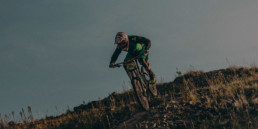The Emergence of Bike Parks
Material on this page has been excerpted from “Vision,” Chapter 1 of Bike Parks: IMBA’s Guide to New School Trails.
In just a few decades, mountain biking has grown from an obscure activity to a well-known pursuit that inspires millions of enthusiastic participants worldwide to put rubber to dirt.
Modern bike parks offer purpose-built trails, designed and built by mountain bikers to maximize the potential for two-wheeled fun. Highly skilled riders had always built jumps and daunting features for themselves, but the early leaders in the bike park movement discovered that it was not enough to solely offer expert-only terrain. In order to succeed and grow the user base, they had to create challenging trails and riding features tailored specifically to each ability level.
In much the same way that ski resorts learned that a beginner skier will become a lifelong enthusiast (and customer) when a supportive learning environment is present, cyclists of all abilities and backgrounds became intrigued by the possibility of developing new skills at bike parks or on flowing, gravity-assisted trails.
Today, the demand for purpose-built bicycle facilities has exploded. Riders, advocates, and land managers are now working together to define the need, and the methods, to create landscapes intended for mountain biking.
Community stakeholders are working together to define what bike parks and bike-specific trails can offer. The context is just as likely to be a public park as a private, fee-based enterprise. These facilities come in varying shapes and sizes, from small neighborhood pumptracks built for a few thousand dollars to municipally operated bike parks with multi-million dollar price tags.
Get to Know “Jump,” “Pump,” and “Flow”
Like most sports, park-based mountain biking has inspired its own vocabulary. It is useful for non-cyclists, land managers, and public officials to understand the importance of terms like “jump,” pump,” and “flow,” and to gain an appreciation of these concepts as they apply to bicycle-specific facilities.
The appeal of jumping is easy to convey. Watch a few kids playing on their bikes for any length of time and you will likely witness an elementary attempt to build a launching platform, using whatever is handy. With experience, dirt jump enthusiasts become incredibly skilled at both riding and sculpting a variety of features designed to produce air time.
Pump describes the technique of generating momentum on a bike without pedaling. By shifting weight on the bike and “pumping” over rollers and through turns, a rider can produce forward motion. A “pumptrack” is a park feature designed to be ridden in this fashion. This pumping action builds focus, concentration, and intensity. Until recently, this riding technique was only understood by expert riders, but with the advent of pumptracks and other bike-specific trail designs, even novices can learn the advantages that come from constant shifts in body position.
Flow describes the roller coaster-like sensations a rider experiences when piloting a bicycle through a thoughtfully designed route. A purpose-built trail maximizes the natural attributes of the terrain while minimizing interruptions imposed by sharp turns or abrupt braking. Flow trails are generally descents, though some climbing sections may be included. They create a rolling rhythm by smoothly combining features like banked turns, rollers, and jumps to guide riders through the landscapes in a seamless fashion. The pursuit of flow is what will draw riders repeatedly back to a park or trail system to sharpen the skills that enhance these sensations.
The suggestions offered in this and other IMBA trailbuilding articles do not constitute a standard, specification, or regulation. Trailbuilders and landowners are responsible for the safety of their own trails and facilities. Freeriding and dirt jumping are high-risk activities that can result in serious injuries. IMBA’s goal is to help land managers and volunteers manage these risks by sharing information.



